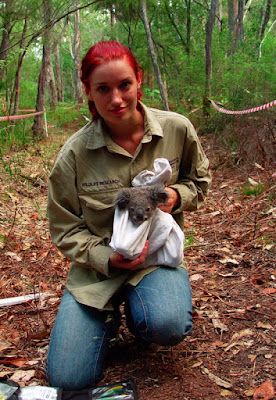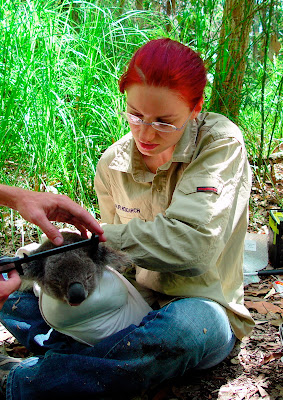We've been working on the ecology of koalas in urban environments for a number of years - but we wanted to share with you some of the data we got in a pilot study a few years ago. It told us a lot about how urban koalas make use of habitat in housing developments!
 |
| Many koalas inhabit SouthEast Queensland |
In late 2008, we looked at the movements of koalas in a new residential development in South East Queensland (SEQ). The development, named Coomera Waters, is located in the rapidly expanding northern Gold Coast suburb of Coomera – an area that's also home to a substantial koala population.The pilot study was coordinated by Dr Robbie Wilson, Dr William Ellis and Dr Sean FitzGibbon and formed the basis of a short research project for Master of Science student Ms Maren Dammann.
 |
| Maren with a study subject |
Despite the iconic status of koalas and their listing as Vulnerable in SEQ, very little is known about how they utilise urban landscapes, where there are many threats to their survival (e.g. dogs, cars, habitat loss). Koalas seem to be relatively resilient animals that can inhabit noisy, heavily disturbed environments provided there are sufficient food/shelter resources and threats to their survival are not too high. But real data showing how to ensure their survival is sadly lacking and desperately needed.
The Coomera Waters development was designed with consideration for the natural environment and wildlife inhabiting it. The estate has kept patches of bushland of varying sizes, some of which are linked through vegetated corridors - places where (hopefully) the koalas can move from one forested patch to another safely. Habitat surveys revealed the presence of a high-density koala population spread across several bush patches in Coomera Waters.
But we wanted to know - are koalas using the bushland corridors? And how much are they moving around?
We fitted 6 koalas with GPS collars, which logged their position every two hours.
 |
| The GPS collar |
After 3 – 4 months the six koalas were recaptured and the collars removed so that the logged movement data could be downloaded. The data were then plotted on an aerial image of the residential estate to examine the extent of their movements (See below: each colour represents a different koala).
 |
Where koalas were found (via GPS) over the study. Each colour is a different koala and each dot is a GPS location. |
The plotted data revealed several interesting aspects of the behavioural ecology of the collared koalas.
1. All of the koalas were found to occupy very small home ranges (meaning, the area where they live; 0.4 – 2ha). Two of the male koalas (yellow & purple) had closely overlapping home ranges and both koalas were recorded to move through residential properties to access bushland on the other side of these housing blocks (see 1. in the figure).
2. One of these male koalas (purple) and a female (green) were regularly recorded crossing suburban streets, suggesting their home range was distributed in bushland on either side of these streets and that they were able to avoid collisions with vehicles during the study (see 2. in the figure).
3. Two of the collared koalas (orange and green) were found to utilise a thin vegetated corridor that connects two larger bushland areas, suggesting that the characteristics of the corridor are suitable to facilitate koala dispersal (see 3. in the figure).
4. Another female (blue) was regularly recorded utilising trees that were retained in the backyard of residential properties adjacent to the bushland where majority of its home range occurred.
5. The sixth animal (female; pink) was never recorded to leave the small isolated patch it was first captured in but it used the entire patch. It's possible that this female was isolated in this patch when urban development of the area was commenced. Alternatively, the requirements of this female may be being met in this small patch, as male koalas may seek her out for breeding purposes and so she may have no need to move from the patch.
 |
| Maren and Bill measure an adult koala |
Our pilot study of koalas at Coomera Waters raised more questions than it has answered. While it revealed interesting aspects of the species behavioural ecology, we've got lots more work to do! We've been doing lots more work on urban koalas since 2008 - we'll be keeping you posted!
Written originally by Dr Bill Ellis; Revised slightly by Dr Amanda Niehaus RSS Feed
RSS Feed Twitter
Twitter








